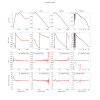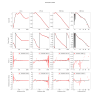[Dan, Hido, Sawada, Yamamoto, Ushiba]
Abstract:
Gain tuning of MICH2DARM, MICH2PRCL, and PRCL2DARM FF were performed.
All update seems fine.
Detail:
First, calibration team measured the actuator efficiency ratio of MICH2PRCL/PRM2PRCL.
The new value was 0.03675 and FM10 of LSC_MICHFF2 filter bank was updated.
Figure 1 and 2 show the filters before and after the update, respectively.
Then, I measured MICH2DARM coupling with several FF gain to tune the MICH2DARM FF gain (fig3).
MICH FF performance seems better when MICH FF gain is 0.98, so I implemented the gain of 0.98 at FM10 of LSC_MICHFF1 filter bank.
Figure4 and 5 show the filters before and after the update, respectively
After that, I measured PRCL2DARM coupling with several FF gain (fig6).
Though the low frequency performance is worse than before, the best gain seems 0.8, so I update FM1 of LSC_PRCLFF1 filter bank.
Figure 7 and 8 show the filters before and after the update, respectively.
For further tuning of PRCL2DARM FF, we may need to modify the filter shape and it takes a time, so I didn't performit today.
Since current PRCL2DARM noise budget cased on the today's measurement is low enough (fig9), the current situation should be fine.
Since all updates are done by overwriting current FF filters, no SDF change happens.









































































